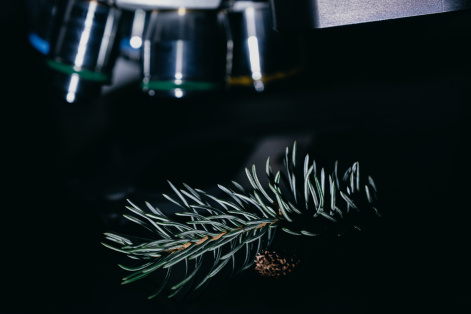Spruce trees are colored blue due to nanotubes
28 December 2020 г.

Many parts of plants are covered with epicuticular wax. It protects leaves from excess moisture and dryness, insect pests and chemicals. When light is incident on a photosynthesizing surface, the first thing it encounters on its way is a wax layer which affects the optical characteristics of the penetrating radiation.
Scientists of the Federal Research Center "Krasnoyarsk Science Center SB RAS" found out that the structural elements of the wax coating of plants are nanotubes. Having studied the effect of the surface layer on the optical properties of the needles of blue spruce and the leaves of glaucous wheat, physicists came to a conclusion that it is nanoobjects that are responsible for the blue color.
In order to study the structure of the wax, it was necessary for scientists to carefully separate it from the plants. Usually, for this purpose organic substances or solutions are used, which can contaminate the test material. Therefore, scientists figured out how to separate the wax using distilled water. Water is an inert and pure material which penetrates deeply into the plant tissues under the action of capillary forces and it is easily removed during drying. The samples were placed in a vessel with water for several hours, and then, cooled to negative temperatures. Freezing, the water expanded and tore off the wax plates from the surface of the leaf. After thawing, the plates floated to the surface, where scientists collected them.
The study of the obtained samples under a scanning electron microscope showed that in both plants the wax coating consists of nanotubes about 150 nanometers in diameter and 1 to 4 microns in length. When comparing the wax of spruce needles and wheat leaves, we found that they differ in fluorescence spectra. In blue spruce trees, the luminescence peak was close to the edge of ultraviolet light, and in wheat it is not far from the green zone. As a result, under the influence of ultraviolet radiation, the spruce becomes blue, and the wheat becomes gray-blue. The difference is due to the fact that the nanotubes in the wax coating of spruce are hollow, while in wheat they are filled, and thus, they refract light in different ways.
“In 2016, scientists from England discovered that a certain photonic-crystal structure in plant chloroplasts rather than pigments is responsible for the blue color of plant. There are many blue fir trees growing in Siberia, we started looking for the reason for their blue color and came across wax, which turned out to be the reason for the unusual color. If to chemically remove this layer, the tree will visually become an ordinary green spruce. We also looked at a variety of glaucous wheat and found out that the thick wax cover of the bluish plants consists of nanotubes. During the study of the spectral characteristics of the wax, we found that it absorbs almost all ultraviolet light and emits it in the visible range of light, or it fluoresces. By absorbing short-wavelength light, the wax layer protects the inner structure of cells from ultraviolet radiation and at the same time, transfers it to the visible region of the spectrum, thereby increasing the photosynthesis efficiency, "says one of the authors of the study, Evgeny Bukhanov, junior researcher at the L.V. Kirensky Institute of Physics KSC SB RAS.
Share:
